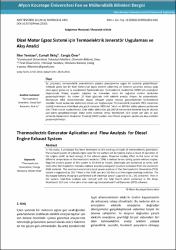| dc.contributor.author | Temizer, İlker | |
| dc.contributor.author | İlkılıç, Cumali | |
| dc.contributor.author | Öner, Cengiz | |
| dc.date.accessioned | 2017-09-26T13:45:02Z | |
| dc.date.available | 2017-09-26T13:45:02Z | |
| dc.date.issued | 2016 | |
| dc.identifier.issn | 2149-3367 | |
| dc.identifier.uri | http://fenbildergi.aku.edu.tr/1602/025901(431-445).pdf | |
| dc.identifier.uri | http://hdl.handle.net/11630/4537 | |
| dc.description.abstract | Bu çalışmada, termoelektrik jeneratörlerin çalışma prensiplerine uygun bir prototip geliştirilmiştir.
Isıtılacak yüzey için bir dizel motorunun egzoz sistemi kullanılmış ve motorun çalışması sonucu açığa
çıkan egzoz gazlarının ısı enerjisinden faydalanılmıştır. Termoelektrik modüllerde (TEM) fark sıcaklığının
oluşmasında ihtiyaç duyulan soğutma ise motordan harici bir soğutma sistemi tarafından
gerçekleştirilmiştir. Bu sistem 20 Watt gücünde anlık elektrik enerjisi ihtiyacı ile çalışmaktadır.
Alüminyum 6061 malzemesinden oluşan sekizgen yapıya montajı gerçekleştirilen termoelektrik
modüller kendi aralarında elektriksel olarak seri bağlanmıştır. Termoelektrik jenaratör (TEJ) sisteminin
ürettiği maksimum elektriksel çıkış gücü motorun 3500 dak‐1 devir ve 100 Nm yükte çalışma şartlarında
156.7 Watt olarak kaydedilmiştir. Elde edilen elektriksel güç DA/DA konvertöre iletilerek boş bir akünün
şarj işlemi gerçekleştirmiştir. Daha sonra sistemin, Ansys Workbench 12.0 içinde yer alan ve aynı
zamanda Hesaplamalı Akışkanlar Dinamiği (HAD) yazılımı olan Fluent programı yardımıyla akış analizleri
gerçekleştirilmiştir. | en_US |
| dc.description.abstract | In this study, A prototype has been developed as the working principle of thermoelectric generators.
The exhaust system of a diesel engine used for the surface will be heated and as a result of operation of
the engine profit by heat energy of the exhaust gases. Required cooling effect in the occur of the
different temperature of thermoelectric modules (TEM) is realised by an cooling system without engine.
Reguired electric power of this system is 20 Watt as instant. Electrically are connected as series with
each other thermoelectric modules realised assembly octagonal structure consisted from the aluminum
6160 material. The maximum electrical output power produce of the thermoelectric Generation (TEG)
system is registered as 156.7 Watt at the 3500 rpm and 100 Nm as of the engine working condition. The
discharged battery charging is performed with electrical power supplied to DC / DC converter. Then in
the system, heat‐flow analysis was realised with the help Fluent which contained in the Ansys
Workbench 12.0 and in the same time meaning Computational Fluid Dynamics (CFD) software. | en_US |
| dc.language.iso | tur | en_US |
| dc.publisher | Afyon Kocatepe Üniversitesi, Fen ve Mühendislik Bilimleri Dergisi | en_US |
| dc.identifier.doi | 10.5578/fmbd.25301 | en_US |
| dc.rights | info:eu-repo/semantics/openAccess | en_US |
| dc.subject | Termoelektrik Jeneratör | en_US |
| dc.subject | Enerji Geri Kazanımı | en_US |
| dc.subject | Atık ısı | en_US |
| dc.title | Dizel Motor Egzoz Sistemi için Termoelektrik Jeneratör Uygulaması ve Akış Analizi | en_US |
| dc.title.alternative | Thermoelectric Generator Aplication and Flow Analysis for Diesel Engine Exhaust System | en_US |
| dc.type | article | en_US |
| dc.relation.journal | Afyon Kocatepe Üniversitesi, Fen ve Mühendislik Bilimleri Dergisi | en_US |
| dc.department | Cumhuriyet Üniversitesi, Teknoloji Fakültesi, Otomotiv Bölümü, Fırat Üniversitesi, Teknoloji Fakültesi, Otomotiv Bölümü | en_US |
| dc.identifier.volume | 16 | en_US |
| dc.identifier.startpage | 431 | en_US |
| dc.identifier.endpage | 445 | en_US |
| dc.identifier.issue | 2 | en_US |
| dc.relation.publicationcategory | Makale - Ulusal Hakemli Dergi - Kurum Yayını | en_US |



















